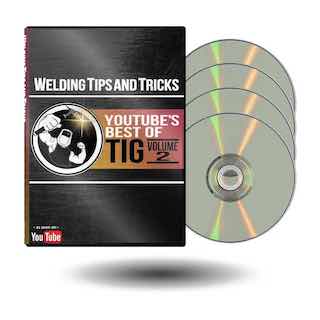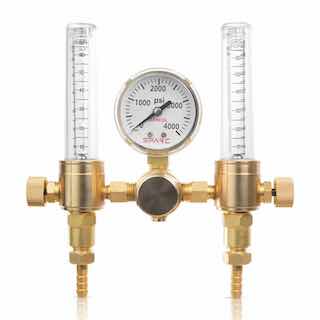Cutting Torch Oxy fuel Safety - Section 2. Handling Acetylene and oxygen Cylinders
Cutting Torch Safety - oxygen and acetylene cylinders
Handling Compressed Gas Cylinders
Under normal conditions, the handling and use of oxygen and acetylene cylinders is very safe. It is the improper use and handling of this equipment that can cause serious damage and injury.
1. Why is it important to keep cutting torch and other gas cylinders secured?
Securing cylinders is important to prevent damage to the high pressure valve, in the event the cylinder were knocked over, allowing the high pressure contents to escape in an uncontrolled fashion.
High pressure cylinders, particularly oxygen, with pressures of 2,000 psi or greater have the potential of causing damage or injury. This potential can occur if the valve assembly on the cylinder is damaged.
Cylinders should always be secured with the valve cap in place, when not in use.
Cutting torch Fuel cylinders, such as acetylene, are filled to a much lower pressure, but fuel cylinders can also be dangerous if the valve assembly is damaged. Another risk to acetylene cylinders would be the creation of voids within the cylinder if it is indented or struck. Voids allow for the acetylene gas to move around more freely. This increases the potential for cylinder explosion, as the gas molecules tend to separate.
2. If an acetylene cylinder has been laid down, should it be put into immediate service?
No.
Did you know that acetylene cylinders are filled with liquid acetone? Acetylene cylinders are also filled with a porous concrete like substance. The liquid acetone saturates the porous stuff and the acetylene gas is compressed into the liquid kind of like the gas bubbles that are in a coke.
When the acetylene cylinder is leaned over or stored horizontally,
There is possibility of acetone being present in the valve which would then enter the regulator.
Acetylene cylinders are filled with an inert porous material, which is then saturated with acetone. Acetylene gas is then charged into the cylinder. The gas then dissolves with the acetone, which keeps the gas stable at low pressures. Since the acetone is a liquid, acetone will flow into the cylinder valve assembly if the cylinder is on its side. Acetone will flow into the regulator if used, which can damage the regulator.
3. What is the maximum regulator pressure setting when using acetylene?
15 psi.
Acetylene molecules are held in solution with acetone in the cylinder. Pressures above 15 psi allow the molecules to decompose or separate. Smith acetylene regulators are set to prevent pressurizing above this threshold. Separation of the molecule can be explosive.
4. What are four types of regulator burnouts (RBO’s)to be concerned about when using a cutting torch?
A. Dust
Always blow out the oxygen cylinder valve assembly before attaching the regulator. If dust has accumulated in the valve, there is potential for a dust explosion if the cylinder is opened rapidly.
B. Oil oxygen
Oils and grease also could cause a regulator explosion. Oxygen lowers kindling temperatures and accelerates combustion.
C. Dissociative gas
Dissociative gas explosions are caused by acetone being withdrawn and entering the regulator.
D. Mixed gas
The fuel gas and oxygen being combined in one or both regulators cause mixed gas explosions. Since the oxygen cylinder has greater pressure, there is more potential for oxygen to be mixed in the fuel side.
Proper assembly of regulators onto compressed gas cylinders should be as follows:
• Blow out oxygen cylinder valve, attach regulator
• Attach fuel regulator to fuel cylinder
• Be sure both regulators are pointed up to minimize damage in the event of a regulator explosion
• Attach hose and torch to regulators
• Be sure both regulator adjusting screws are in the out and off position
• Open oxygen cylinder SLOWLY, to avoid heat of recompression (capable of creating up to 1700 degrees F); open valve completely; standing with cylinder between you and regulator
• If using acetylene, open fuel cylinder ½ to ¾ turn; standing with cylinder between you and regulator
• Make sure torch valves are in the off position
• Turn in adjusting screw to desired pressure on both regulators
• Check all points the system for leaks, with approved leak detection solution, or non-oil based soapy water
• Purge each line by opening the torch valves for a few seconds and close
• cutting torch is Ready for use
Ready for Section 3? see below
• MAIN PAGE ON CUTTING TORCH OXY FUEL SAFETY
• SECTION 1. Understanding the fundamentals of combustion
• SECTION 2. Proper handling of compressed gas cylinders.
• SECTION 3. Oxy-Fuel gas characteristics
• SECTION 4. The burning process
• SECTION 5. Proper operation of oxy-fuel heating tips
• SECTION 6. Oxy-fuel Equipment inspection
• SECTION 7. Oxy fuel Safety torch - tips
see main page on cutting torch safety














